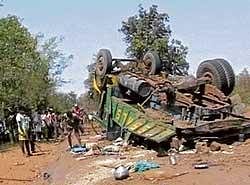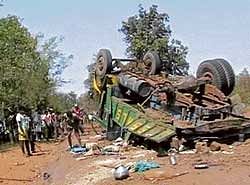

But it was spreading ever since and now covers as many as 195 districts across 16 states - i.e., roughly a third of the country. But the successive governments, in their deep slumber, let it pass. The radical left, now known as Maoists, has expanded and taken deep roots mainly along the country's tribal regions where “backlash of the development” and subsequent “alienation of land and resources” helped it to swell its cadres strength.
The 58 highly affected districts are mainly concentrated in Chhattisgarh, Jharkhand, Orissa, Andhra Pradesh, West Bengal, Bihar, Maharashtra and Madhya Pradesh. Parts of Uttar Pradesh, Uttarakhand, Karnataka and Haryana too have some pockets of Maoist influence. Security forces have no access to the Maoist “liberated zones” where “Dalams” (Maoist armed squad) under Communist Party of India (Maoist) rule and dispense instant, unforgiving justice.
Last Tuesday, the ill-fated Central Reserve Police Force (CRPF) contingent met its nemesis at Mukrana in Dantewada district of Chhattisgarh while on a “domination” exercise in the Red-controlled zone. The southwest part of Bastar belt in the state is an impregnable Maoist bastion.
The gradual consolidation by the left extremists remained invisible along the long stretches of forests where penetration by security forces is as difficult. Nearly 10.03 million hectares of forests in the country are presently controlled by the Maoists. The thickly forested “Dandakaryana” region is a perfect hideout for the Reds and their faceless commanders. The “Dandakaranya” comprises Khammam, Nizamabad and Warangal in Andhra Pradesh, Bastar, Dantewada and Rajnandgaon in Chhattisgarh, some parts of western Orissa, Gadchiroli and Bhandara of Maharashtra and Balaghat district of Madhya Pradesh.
The so called `Red corridor` the left extremism has stretched to the neighouring Nepal where ironically the Maoists under their helmsman ‘Prachanda” are now in the political mainstream and are not averse to having liberal experimentation with “Yoga” after the ouster of the retrograde royalty.
The Red march has in recent years attained a high degree of decibel with the Centre and State governments seeing it as “the greatest threat” to the internal security but yet failing to take adequate steps to counter the threat. The alarm bells have rung loud but the Central government is still apparently caught in a “welfare or warfare” dilemma. The half-hearted development plans, mainly focusing on “market economy” benefiting big mining industries and MNCs, have not answered the basic needs of food, health, education and above all justice to the ‘Adivasis’, seldom considered part of the “mainstream” or treated on par with urban populace.
The evolution of the left-extremists from a hit-and-run group to large armed mobile formations, capable of taking large battalions and escape with impunity has surprised the policy planners in the North Block in New Delhi.
The Maoist offensive grew stronger after the three left-wing extremist groups operating in different states, including People's War Group in Andhra Pradesh, merged to form Communist Party of India (Maoist) on September 21, 2004.
The Maoists are now a banned organisation with the Centre maintaining that dialogue with the rebels is possible only if they abjure violence and surrender their arms- a possibility as remote as government winding up its operation “Green Hunt” to defeat them. The massive extremist ambush in Dantewada has provoked the government to flex its muscles and show that it has enough teeth to bite. But there is a big question mark as to how to hit back and hit back hard without inflicting collateral damage on the tribal people.
There is no doubt that the Maoists have, rightly or wrongly, enough ground support from tribal people whose interests they claim to represent. The ill-conceived and unconstitutional "Salva Judam" that involved mobilisation of tribal people to take on the Maoists has further alienated the tribals who, for long, have been caught in the cross-fire of the security forces and that of the rebels.
The Centre cannot hope to win “the war” against the Maoists unless it has people's backing in the areas where the rebels have entrenched themselves. Lack of human intelligence in the tough forest terrains is a natural corollary to the fact that the Maoists have been more successful in insulating their strongholds. But this did not happened in one day. In last 60 years, there has not been any substantial “decentralisation of development”. This may be the case in most parts of the country but in the states like Chhattisgarh, Jharkhand and Andhra Pradesh, it is the Red-resistance that brought into sharp national focus the issue of underdevelopment.
The Union home ministry, which is ultimately responsible to ensure law and order in the country, had once held the view that it was the responsibility of Union ministry of social justice and empowerment to deal with the issues of development, protection of rights and justice.
The separation of the Ministry of social justice and empowerment from the Ministry of Home Affairs has apparently resulted in the government not seeking "the big picture" on link between the rise of the left-wing extremism and underdevelopment. The chapters V and VI of the Constitution which grant inalienable rights of land and other resources to STs/SCs have been rampantly violated in the Maoist-influenced states. Director of Jungle Warfare in Chhattisgarh Brig. G K Punwar admits to “acute disparity” between tribal people and “the mainland people”.
Even on the security front, the government has, for decades, been speaking in terms of on modernisation of police, arms, ammunition, communication network, transport and that of motorable roads in the Maoist-infested regions but the money allocated for the purpose has mostly remained unspent. The CRPF which has been trained to deal with riot situation is finding itself hardly a match to the quick-footed armed Maoist cadres who have adapted guerilla tactics from the Red book of Mao. The police atrocities, human rights violations and complete unaccountability of security forces have turned the popular sentiment against the establishment in the country's tribal areas.
The solution is not in treating the symptoms but the disease. Dr Vinayak Sen, arrested and kept in jail for two years for his alleged Maoist affiliations, speaks logically when he says that Bilaspur in Chhattisgarh has no Maoist influence but the majority there suffer from chronic malnutrition. During the August to October rice scarcity in the area diseases like Malaria, TB and Nutritional Acquired Immune deficiency are common. “Chief Minister Raman is described in Chhattisgarh as ‘chawalwale baba’ as his government distributes cheap rice. But even that is not available”, says Dr Sen.